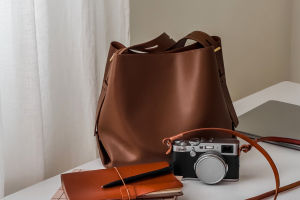You know the scene: a pile of jeans in the fitting room, zippers fighting back, waistbands gaping, and nothing quite right.
Finding jeans that actually fit—not just close—is frustrating. And it's not your body that's the problem. It's the denim cut that isn't working for your shape.
The good news? Once you understand what to look for—based on your hips, thighs, and leg length—shopping for jeans gets a whole lot easier (and way less emotional).
Let's break down how to choose the most flattering denim styles for different body proportions—with real-world advice, not vague generalizations.
If You're Curvy at the Hips
Wide hips and a smaller waist are a gorgeous contrast, but standard jeans often gap at the waistband or flatten your natural shape.
1. Go for contoured waistbands: Look for jeans labeled "curvy fit." These are designed with a smaller waist-to-hip ratio and help avoid the dreaded back gap.
2. Mid-to-high rise works best: Mid-rise jeans that sit just below your belly button offer comfort without cutting into curves. High-rise styles are great too—just avoid ultra-high styles that may flatten your hips.
3. Bootcut and flare jeans balance out proportions: These cuts help visually balance fuller hips and make legs look longer.
Avoid: Low-rise jeans without stretch—they tend to ride down and emphasize the widest part of the hip.
If You Carry More Weight in the Thighs
Strong or fuller thighs can make skinny jeans feel tight and uncomfortable, even when the waist fits.
1. Look for straight-leg or relaxed fit: These styles skim the thighs without clinging, offering a flattering drape.
2. Stretch is your friend: Denim with 1–2% elastane adds just enough give to move comfortably without sagging.
3. Dark washes have a slimming effect: Especially with a clean front (no whiskering or fade), dark indigo can lengthen and slim the leg line.
Pro tip: Some "slim straight" cuts are the perfect middle ground—not as tight as skinnies, but still modern and shapely.
If You're Petite or Have Shorter Legs
When your legs are on the shorter side, the goal is to visually lengthen them and avoid getting overwhelmed by fabric.
1. High-rise jeans elongate: High-rise styles create the illusion of longer legs by lifting the waistline.
2. Cropped straight jeans work wonders: A slightly cropped leg (hitting just above the ankle) avoids bunching and shows off your shoes.
3. Vertical seams or front slits help too: These details draw the eye downward and stretch your proportions.
Avoid: Wide-leg jeans with excessive length unless you plan to wear platforms—they can shorten the frame.
If You Have a Long Torso
A longer torso often means high-rise jeans can feel like they never actually reach your waist.
1. Go for ultra-high rise: Some brands offer 11"+ rise measurements, which help visually balance your proportions.
2. Try a front-tuck or cropped top: This shortens the torso visually and brings the focus to your waistline.
3. Look for elongating leg cuts: Bootcut or flare styles draw attention to your legs and balance out a long upper half.
Don't Ignore the Fabric Label
Stretch matters—but not all stretch is equal.
1. 100% cotton = classic but rigid: It molds to your body over time, but can feel stiff at first. Best for vintage-style fits or structured straight jeans.
2. 98% cotton + 2% elastane = sweet spot: Gives a little flex while holding its shape. Great for daily wear.
3. More than 3% stretch = ultra comfort: Jegging-like softness, but can bag out after a few hours. Choose this only if you like a super snug fit.
How to Test Fit Without Overthinking
Still not sure in the dressing room? Try these quick hacks:
• Waistband check: Slip two fingers in the back—snug but not tight is ideal.
• Sit test: Can you bend or sit without feeling pinched? Comfort counts.
• No bunching at the crotch or knees: This often means a better inseam match.
Ultimately, the best jeans aren't about trends—they're about confidence. When your jeans sit just right on your hips, hug your curves without squeezing, and let you move freely, you feel strong. And that shows.
So, what's your biggest challenge when jean shopping? Waist gaps, thigh tightness, or leg length? Let's figure it out together—because there's definitely a pair out there with your name on it.


